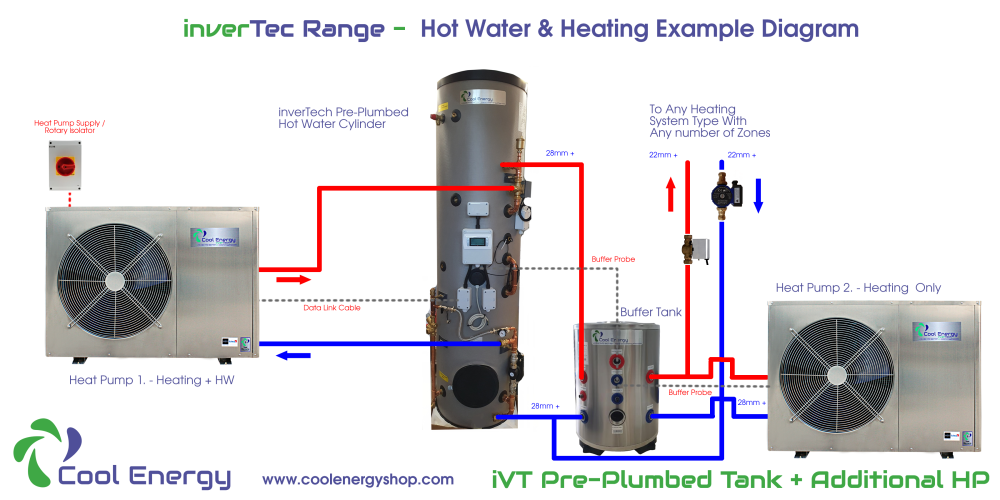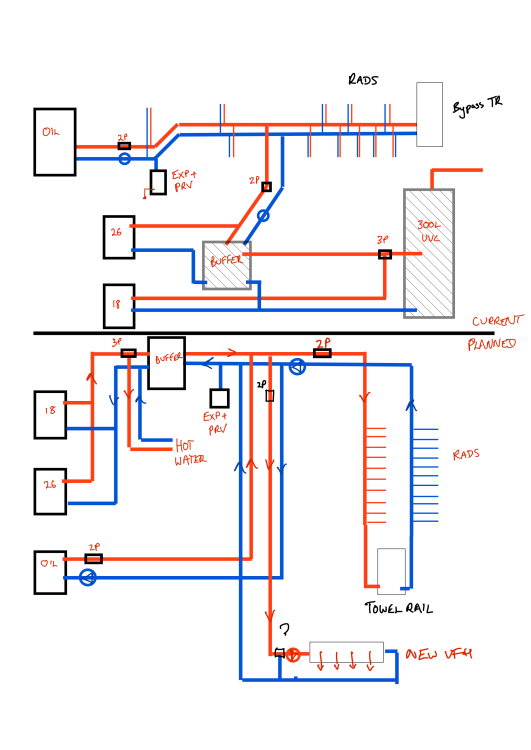
Wil
Members-
Posts
305 -
Joined
-
Last visited
Everything posted by Wil
-
Use PIR (or mmWave) in the bathrooms to switch the recirc pump? On only when room in use.
-
Downdraft Extractor Ducting Route
Wil replied to carson321's topic in Kitchen & Household Appliances
Are you having MVHR? Best to have the downdraft re-circulate into the island via carbon filters and do your air removal through the nice efficient MVHR if a new extension. definitely don’t want kitchen grease building up in a void under the floor. Where does the air go if you shove it into the void? If you do duct to outside put a good non-return flap on it- Our friends have a permanent towel over their hob when not in use. -
The connectors on my CE unit burnt too causing all sorts of fun (including a RTB). Upgraded connectors solved all woes.
-
Hah, my builder’s plumber managed this on our recent UFH install too. Fortunately a quick swap because of his other poor work. You do worry about some trades… At least it’s an easy fix 👍
-
MVHR and cooling
Wil replied to flanagaj's topic in Mechanical Ventilation with Heat Recovery (MVHR)
Yep, pretty much exactly that! Sort of limits furniture placement too. -
MVHR and cooling
Wil replied to flanagaj's topic in Mechanical Ventilation with Heat Recovery (MVHR)
I’ve always wondered about this DIY approach with the routered boards on the wall and plaster over UFH pipes. Not quite been brave enough to try it at my place though 😞 -
Ah sorry, misunderstood the question. I spent ages looking at the pin config for the cat5 because my 26 came without the pre-wired RJ45 connectors. I’ll have to go back and look again. I’ve honestly only briefly run them in cooling as far as the buffer as my internal pipework isn’t properly insulated. Look forward to the day I can actually run them for cooling!
-
@Bramco If you’re just looking for how to turn off HW and run in heating or cooling only- need to set the Carel controller to OFF first then under ‘user controls’ you can cycle through the options. Stumped me for a bit that it had to be OFF. For the wiring, mine was a simple RJ45 between indoor and outdoor. I can talk you through connections with pictures if needed.
-
I ended up boosting the immersion for an hour with my final 4.30-5.30am cheap rate to make sure there’s always enough for the morning showers. Couldn’t get the time settings to reliably boost the heat.
-
Ufh manifold, blending valve with ASHP.
Wil replied to Russell griffiths's topic in Underfloor Heating
@NickfromwalesThank you, I’ll insist he changes it. -
Ufh manifold, blending valve with ASHP.
Wil replied to Russell griffiths's topic in Underfloor Heating
Yep, it certainly makes the meter spin when it all runs together. Ah yes, only one can ever do the DHW, currently the 18. I would aim to drop the 26 altogether in the future. In the CE diagram 18 is on the left and 26 on the right. The intent of the proposed was to allow them to run in parallel for heating and one for DHW but that’s not what is shows! I’ve read in the other threads about removing buffers and using volume of system (my house is plenty cold enough there’s valves open). But specifically at the moment is is the pumped UFH system the correct approach? Can I simplify as per JohnMo’s example or is the current setup optimal in terms of feed. -
Ufh manifold, blending valve with ASHP.
Wil replied to Russell griffiths's topic in Underfloor Heating
@JohnMoThey’ve been installed per top scribble for 3 years. I appreciate the ridiculous oversizing but I have another project this 26unit will move to once I finish the upgrades to the main house and can prove just the 18 copes. this is the ASHP setup as per CE: -
Ufh manifold, blending valve with ASHP.
Wil replied to Russell griffiths's topic in Underfloor Heating
I’ve got an 18 and a 26 in a weird parallel situation (blame Cool Energy for the upsell!) I’m hoping to get to just the 18, but it does defrost a lot and the 26 helps carry through those moments. -
Ufh manifold, blending valve with ASHP.
Wil replied to Russell griffiths's topic in Underfloor Heating
@Nickfromwales see scribbles below. Current above, planned below. The idea is I could eventually drop the oil and the 26kW ASHP but they’re there anyway so might as well use them. -
Ufh manifold, blending valve with ASHP.
Wil replied to Russell griffiths's topic in Underfloor Heating
A pretty terrible scribble, give me a few mins to tidy it up! -
Ufh manifold, blending valve with ASHP.
Wil replied to Russell griffiths's topic in Underfloor Heating
@Nickfromwales Thank you. If it was just an ASHP, would it be acceptable to have no control? Is there any point in the 4 port and pump? Why not just run it as a big radiator? -
Ufh manifold, blending valve with ASHP.
Wil replied to Russell griffiths's topic in Underfloor Heating
First of all- HOLY THREAD RESSURECTION! But hoping @Nickfromwales might be able to confirm if the advice above has been superseded- The builder’s plumber turned up, saw an ASHP and looked no further. He then supplied a manifold with a pump and no mixing valve- just some sort of fixed 4 way and a pump. I have the ability to run the oil boiler in to the heating circuit and the Buffer tank has an immersion in it- so I would consider a TMV still required. He just keeps saying ‘it’s fine for an ASHP’ - is it ever fine to not have a TMV? -
(ASHP-based) Hot water tank gets cold surprisingly quick
Wil replied to puntloos's topic in Boilers & Hot Water Tanks
Ah yes, I missed the sqft, not sqm. Still 512m2 is pretty damn impressive! Unless you can get a large scale turbine PV will outperform it- I have a 1kWp unit and on its best day ever it managed 2kWh of generation often the daily is nothing or a few tens of Wh. The 5kWp PV regularly outputs 20-25kWh peaking at 35kWh in a day. The turbine isn’t ideally sited, but you’d need planning permission for a full tower and a much bigger unit to get a decent output. I’d have to say the PV looked better at that point. -
(ASHP-based) Hot water tank gets cold surprisingly quick
Wil replied to puntloos's topic in Boilers & Hot Water Tanks
Can I come see it, I’m near Titchmarsh and being nosy about a 9000m2 Barn conversion? 🙂 Sounds like there’s lots to consider with GSHP and secondary circuit. Do you have an PV or anything you can divert into the newly wired immersion? -
TBF the biggest issue with the Powerwalls is that they aren’t a UPS and can allow a brownout as the power drops which means a lot of stuff switches off. Once they get hold of the load they can output 10kWp (14 for short duration) and keep the basic inverter online so the power keeps running. The power drop almost always gives a big enough spike to take out my main 100mA RCD though, so they can’t return to grid until I reset it. I’m very jealous of some of the consumption figures- I imported 20.1MWh last year…
-
Impressive Mike! My solar only produced 785kWh (unshaded SSW array in the Midlands) in May! £150 back would be a pretty nice payday! My installer has now enabled export on the batteries so I can dump what’s left in them at the end of the day at 15p and then immediately charge them back up at 7.5p. Will see how that goes for a bit before deciding how much I want to fully cycle them every day.
-
I’m assuming that I would have used the import energy anyway and been paying for it. So every penny in export is effectively ‘gain’ from my previous situation. It’s probably too simplistic as the solar charging the battery would have meant less charging the following night. Either way- today I’m at 25.4kWh import and 20.5kWh export so figure I’m up for the day. The £250 is also a LOT less than I would have paid for an MCS install- am I allowed to offset that cost?
-
Turns out by changing the tariff in my Tesla App, it’s sorted itself out and is now exporting all the solar and just slowly discharging the battery to cover the house. Haven’t seen what it does when the house loads look like they’re going to exceed the battery capacity during the day but got 13kWh of export yesterday vs 34.3kWh of off peak input (house/car/battery charge). Once it settles down I should be able to see what my break even on the £250 is going to be! 1667kWh of export either way.
-
I can’t export my battery sadly as it was set up prior to any export agreement. I let the HW charge from the ASHP whenever it needs but have been dumping solar into it until recently. You make a good point though- I could export the batteries to 30% (in case the HPs kick in during hte day) and only export the solar.
-
I’ll answer my own question- i got an email a day later saying i was now on octopus outgoing… now have to adjust my automations to not consume every last drop. 15p/export vs my night rate of 7.5p means worthwhile exporting once the battery and the hot water are complete.



